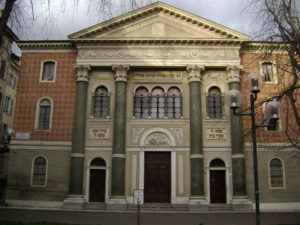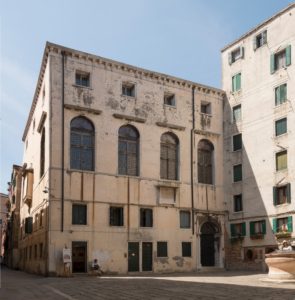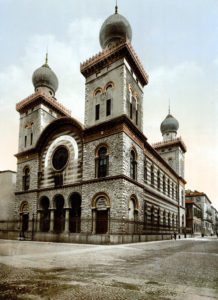Bar mitzvah ceremonies for boys have existed for hundreds of years. There were sporadic attempts to create comparable rituals for girls, but none had a lasting impact until the 1800s.
The main precursor to modern bat mitzvahs was the nineteenth-century annual Religious Initiations for girls, mainly in certain German and Italian synagogues, but also less commonly in other countries such as Poland. Today, the Between Wanderings blog explores these “proto-Bat Mitzvahs” through letters published in Italian Jewish magazines around 1900. They tell us much about attitudes towards women and gender, even in the relatively progressive temples that embraced these ceremonies.
Let’s start with the words of Emma Boghen Conigliani, a noted educator and literary scholar who belonged to the Jewish Temple of Modena, Italy. This letter appeared in the 1899 volume of Il vessillo israelitico, starting on page 185:

The Tempio Israelitico di Modena (Jewish Temple of Modena), built in 1873. [2008 photo by Dread83, distrib. under GNU Free Doc. License.]
For several years, a beautiful new female celebration has been brightening Jewish temples: the religious initiation of girls. This ceremony, held in Verona on the first day of Passover starting in 1844, was introduced in Modena a few years ago by our revered and devoted Rabbi, Mr. Giuseppe Cammeo. He is deservedly well regarded by our whole Congregation, which he has served excellently, instilling all the moral and religious values that are the hallmark of every good citizen.
Synagogues in Ferrara, Venice, Milan, Rome and Trieste followed this laudable example, and it would be well if it became standard practice everywhere.
Much has been written about women’s importance in religion. “Good citizens are formed on a mother’s lap,” as the saying goes, but without moral and religious values, no one can truly be a good citizen.
Christianity boasts that one of its finest, most civilizing principles was that it raised the status of women, but Jewish history also offers distinguished female paragons whom the whole nation reveres. Indeed, alongside the priestly figures of the patriarchs and prophets, we see Sarah, Rebecca, Leah, Rachel, Moses’ mother Yocheved and his sister Miriam, Queen Esther, Deborah and the prophetess Huldah, who are celebrated in the poetry of every nation and of whom Judaism is proud.
It is fair and good for the synagogue to solemnly welcome girls who, on the threshold of young womanhood, are starting to take on the rights and duties of women, among which their religious rights and duties should be held in high esteem. Faith is the supreme comfort and joy of the female heart, and so a woman—with her sweet, pure, powerful influence as a mother, sister and wife—can nobly keep alive in men’s minds the flame of religious piety, from which many virtues derive.
Naturally, before being welcomed formally into the congregation, the girls must have studied Hebrew and must know their Bible and catechism. Otherwise this would all be reduced to just a festive and emotional celebration. For these girls, the memory of the white dress and alabaster veil symbolizing the purity of these souls that still know nothing of life, the memory of the gaily illuminated temple adorned with flowers, and the image of the crowd they pass, to be greeted and accompanied by the clergy, are linked inseparably to the memory of the knowledge they have gained and the new, serious ideas they have learned, which their mind must retain. And because their imagination and heart are deeply moved, they are less likely to lose those ideas and that knowledge. Even time itself, which erases so many things, cannot erase the sweet impression of this experience from their young minds.
Catholics, especially Catholic girls, never forget the day of their first communion, whose healthy influence—they say—lasts a lifetime; and this religious initiation, in the spirit of our own faith, is no less rich in fine poetry, no less wholesomely educational.
Among the most treasured images of their adolescence, our young women can cherish the happy, pure memory of that solemn day, and can find comfort and lessons for adulthood in it.
Now let’s zoom in for a close-up of a specific ceremony. Rabbi Giuseppe Bassi wrote this letter to Il corriere israelitico (vol. 39, p. 39) on June 25, 1900. This was just five years after his congregation—the Sephardic synagogue of Venice—held its first coming-of-age celebration for girls.

The Scola Spagnola (Sephardic synagogue) of the Venice Ghetto, built in the 16th century. [2015 photo by Didier Descouens, distrib. under Creative Commons Attribution-Share Alike License.]
When our Congregation introduced a religious confirmation ceremony for girls in 1895, we predicted the innovation might encourage families to ensure their children’s religious education. And thank God our commitment bore fruit: the girls in this year’s sacred ceremony proved they had sufficient instruction in reading Hebrew, in the Bible and in the catechism. Nine of the confirmands attend our girls’ school, where they are taught patiently by the Chief Rabbi—the Rev. Dr. Moisè Coen-Porto—assisted ably by the school’s capable principal, Mrs. Stella Dina.
To our deep satisfaction, the examination showed that even girls from our most prominent families were well prepared, and we take this opportunity to praise the cultured, distinguished Mrs. Adele Franchetti-Musatti (worthy companion of our Congregation’s meritorious vice president, Giuseppe Musatti, Esq.) who did such a good job teaching three fine little girls[1] from her own family. And we are also pleased to acknowledge and praise the esteemed Usigli family in the neighboring city of Treviso. Some time ago, they hired me as religious tutor to their pleasant daughter Lidia, who celebrated her confirmation this year.
On the first afternoon of Shavuot, our Holy Spanish Temple was filled with ladies and gentlemen. In the places of honor sat the patronesses, along with the confirmands’ relatives and the Congregation’s leaders. To the sound of the organ, the choir began singing the Baruch Habah and the 16 white-clad girls entered the Holy Temple and walked to the Ehal [Ark]. There they were met by the Chief Rabbi, who gave a lovely speech reminding them of the importance of the ceremony they were about to perform and, with brotherly advice, pointed the way towards being worthy daughters of Israel. He reminded them of a woman’s duties in the sanctuary of the family and commended the practice of every religious and moral virtue taught in the Holy Law of God. The choir then sang a Psalm beautifully, and the Rabbi whom we already praised above opened the Holy Ark and bid two dear girls approach: Giuseppina Iachia del Cav. Avv. Salvatore and Lina Melli di Luciano, who read a brief prayer in Italian with emotion and with clear voices. All together, the young girls chanted some Bible verses and approached the Rabbi, who gave them his solemn blessing.
Each confirmand received a copy of Imre Lev as a souvenir of this fine celebration that made such a pleasing impression on everyone.[2]
The following distinguished ladies were chosen as Patronesses this year: Ancona-Coen Bice, Ancona-Levi Adele, Dina-Morpurgo Emilia, Gentilomo-Gnignati Luigia, Luzzatto-Fano Lina and Silva-Usigli Matilde, who all promised the Chief Rabbi they would cover certain expenses for needy confirmands…
To conclude, here is part of a letter signed by Bettina Levi A., a member of the Turin Synagogue, in the 1900 volume of Il vessillo israelitico, starting on page 376:

The Sinagoga di Torino (Turin Synagogue), seen here in a Photochrom print from the late 1890s or early 1900s. This synagogue, too, is still standing. [U.S. Library of Congress, Photochrom collection. Color corrected.]
…Religious initiation ceremonies for girls, which I saw celebrated with some solemnity here in Turin and which are already accepted in other Italian cities, gave me hope that even our communities’ elders have finally come to the same conclusions as I. It was moving to see, in front of the Holy Ark, an inheritance that could once be claimed only by men and Priests; to see the sixteen girls dressed in white; and to hear them speak the first and greatest words of our faith. I hoped the solemnity of that moment would be etched indelibly on their young hearts and make them strong and good: strong in their belief and observance of their faith, good in their charity and in their compassion for those who stumble and lose their way.
But to prevent this simple, moving ceremony from degenerating into a pointless parody, girls’ religious education must be serious and accurate, and the ceremony must be available to all girls, regardless of wealth or station, so that next to the elegant veil of the rich girl we can see the poor, clean little dress of the needy girl.
In this respect, I have confidence in the zeal and influence of the Rabbis, but also great trust in the good sense, discretion and affection of the Jewish Mother. This is her highest, her finest, her holiest mission on earth.
Obviously, none of the above reflects modern full-fledged egalitarianism, but these were major steps towards inclusiveness. They tell just part of the story of how we got from there to here.
ACKNOWLEDGMENTS
The first and third letters quoted here were found in a 1990 booklet coauthored by the Chief Rabbi of Rome, Rabbi Riccardo Di Segni: Il bat mitzvà in Italia: Una riforma discussa. Rather than translate from that quoted text, I went back to the original magazines, which I found in the Dorot Jewish Division of the New York Public Library. The second letter in this blog post was found by doing keyword searches on Google Books, in the magazine Il corriere israelitico.
Grazie to Allan Altman for helping me decipher one particularly thorny passage in the Italian.
[Translations © 2016 by Steven Capsuto]
[1] Translator’s note: The Italian word is ambiguous: it could mean they are her granddaughters, nieces or great-nieces.
[2] Translator’s note: Imre Lev – A nineteenth-century French collection of Jewish prayers and meditations, also published in Italian and other languages.

“They tell us much about attitudes towards women and gender, even in the relatively progressive temples that embraced these ceremonies.
”
I disagree that http://stkildashule.org.au/wp-content/uploads/2013/06/Bat-Mitzvah-ceremony-brochure_v2.pdf
Thanks for your comment. I’m not sure, though, what point you’re raising. Could you clarify?
This post was about bat mitzvahs in the nineteenth century. At that time, the few synagogues performing bat mitzvahs did tend to be somewhat progressive. The Orthodox synagogue in your link didn’t have them until the 1930s.
I’ve only just come across this post fomr 2 years ago – thank you! I would not call these ceremonies either bar or bat mizvahs, but rather confirmations as Rabbi Bassi himself calls it. Confirmation (explainign and accepting tenets of Jewish “faith” rather than reading from the Torah as at a bar Mitzvah was begun in German Reform congregations in the early 19th century (1803 or 1814 depending on definition) and girls were soon included. confirmation was meant to focus more on understanding than on ritual performance. Despite being held on Shavuot – the marking fo the receipt of the Torah by Moses – the confirmation cermet itself downplayed the importance of an specificity of the Torah as opposed to the concept of the Torah. In America, Isaac Wise began the tradition in Albany in 1845. I had not considered the adoption of the custom so completely in the still nominal Orthodox Italian synagogues…and I found it difficult to imagine the ceremony and where the girls sat and where the “patronesses” sat during the service. Normally in the Spanish and Levantina synagogues women were relegated to a very high and mostly enclosed gallery. I am particularly interested in tracing “where were the women” in the synagogue in Europe and America, and studying more the actual physical spaces and experiences of women who chose to attend synagogue. The letters you’ve included here give me something more to think about …Thank you so much! Sam Gruber
You can follow one of my blogs on Jewish art and Architecture at http://samgrubersjewishartmonuments.blogspot.com/
I’ve begun posting more about the experience of women the synagogue and will link to your post, too.
Thanks for your reply, Sam.
You’re right, of course: these are not bat mitzvahs per se, which is why I referred to them in the blog post as “forerunners” and “precursors” to the modern bat mitzvah. They were a “foot in the door” at a time when having girls participate so openly at the front of a synagogue was considered strange and novel. And thank you for sharing the link to your wonderful blog! I’m enjoying it very much.
BTW, you might also find my previous blog post of interest: https://betweenwanderings.com/2016/09/19th-century-jewish-women-beyond-the-balcony-part-1/.